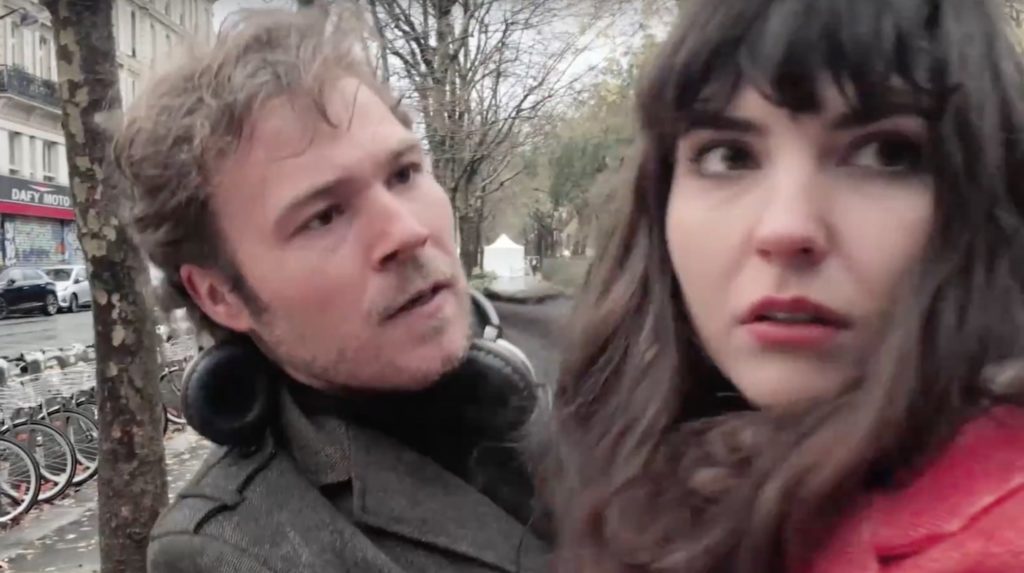Guerrilla filmmaking suggests low-budget projects shot on real locations, which are used without obtaining permits. The casts will be small with each crew member handling a variety of jobs. Typically, the films will fit into a dramatic genre such as romance, horror, or thriller. But as Los Angeles-based choreographer and dance teacher Lilian Manansala shows us, the approach can work beautifully with more artistic forms. Her “lo-fang’s #88” recently won the Best Music Video at this year’s Mobile Motion Film Festival. In the interview (below), the filmmaker talks about the joys and challenges of making a guerrilla music video.
Interview
MMM: How did you develop your filmmaking skills?
Manansala: Mostly trial and error. Lots of observation when I’m on set as a choreographer. Also sitting in on film classes at a high school where I used to teach. And learning from books and YouTube videos.
MMM: Did any films inspire you?
Manansala: My favorite films happen to be about the underdog: “Shawshank Redemption,” “Little Miss Sunshine,” “Amelie,” “Lars and the Real Girl,” and “Babe.” It’s the style in which the writers and filmmakers told these stories that make them so impactful. I also find the dance videos of choreographer Larkin Poynton very inspiring and moving.
MMM: What motivated you to make a dance film—as opposed to choreographing a performance on a traditional stage?
Manansala: I love video’s ability to fine tune the development of the narrative. The medium allows for specific points of view, not just with framing and setting but also timing, degrees of close-ups, angle, color grading, editing, and special effects. While creating a live performance offers plenty of challenges depending on the venue, stage, audience, and purpose of the performance, with film you are giving the audience a direct, purposeful lens. I love the specificity of it. It’s an exercise of direction and re-direction—but I am careful to not go too far into outright manipulation.
MMM: Can you talk specifically about the origin of “88”?
Manansala: I had been wanting to create a filmed piece to this song for a while. A lot of times a song will call for a video, other times it’s perfect for stage. I knew too that the location was going to play a significant role in the blocking of the piece. I usually create to the setting when I am filming a video. When I am setting a piece for stage, I choreograph specifically to the dancers—their strengths, personalities, energy, the connections they have with each other.)
MMM: And it’s different choreographing for video?
Manansala: Absolutely. It’s not just the movement but the way in which I have the dancers relate to each other and how they approach their performance in terms of projection. In film, the audience exists through the centralized location of the lens. So the energy isn’t the same as when you are projecting into the house of a theater, forum, or stadium. But to be clear: like acting for theater, the performance of the dancers in a video isn’t necessarily smaller; it’s just more focused, sometimes straight into the lens, which is the equivalent of the 4th wall in acting.
MMM: How did you find those excellent dancers?
Manansala: Nati and Bruno are students of mine at Degas Dance Studio in Encino, California. Getting them on board wasn’t difficult at all. And they were perfect for this piece not just because of their technical and artistic abilities and range but because of their ability to go with the flow, improvise, and adapt. Their easygoing personalities made the shoot possible.
MMM: How so?
Manansala: We were filming without express permission so I couldn’t keep the kids and parents off the playground nor ask them to move. This was their neighborhood playground and I was only a guest, and an unauthorized one at that. Normally, I shoot with a director of photography (DP) or videographer and I direct. But with this project, I wanted it to be as low budget and low-key as possible. So I covered it all including directing, producing, camera operating, wardrobe, crafts, overseeing the choreography, and keeping us on schedule. If Nati and Bruno were not the pleasant, positive, conscientious optimists that they are, the whole experience—and therefore final product—could have been an outright disaster. The dancers were awesome and essential in this piece.
MMM: Why did you shoot with a smartphone?
Manansala: Simply put, budget. I usually spend my budget on location, the videographer/DP, and craft services. But I had spent so much that summer on other projects, I really had to scale down for this one.
MMM: Besides the phone, did you use any other gear during the shoot?
Manansala: I used my Zhiyun Smooth Q stabilizer, which is battery operated. That was it. And for playback, I used the ARCHEER 25W Bluetooth Speaker which has great volume and looks quite handsome as well.
MMM: In the outtakes, you mention doing one shot 19 times.
Manansala: From load-in to wrap, it took about four hours. I try to work fast so the dancers never get too tired. That day was also very warm. August in Southern California is not ideal for strenuous outdoor shoots. We also had rehearsed pretty extensively, not just the movement but the camera blocking as well. The dancers didn’t attend the location scout so they got the visuals of the “set” from my videos. We did our best to recreate the pathways, setting, and distance in the dance studio where we rehearsed. I knew the last segment—coming from the amphitheatre to the chess tables—was far in distance, but I had underestimated it. To make it work, we did an edit cheat using one of the beams supporting the playground canopy.
MMM: Could you define “guerrilla filmmaking”?
Manansala: This approach—shooting with what’s on hand, having a scant budget, a barebones crew, often permitless—offers so much freedom to new filmmakers. The minimal crew affords flexibility and speed (I didn’t need to consult anyone save me and the cast), and low- to no-budget projects generate a resourcefulness and can-do attribute. Often I find myself MORE creative and innovative when given constraints and obstacles. This style of shooting is born out of necessity—to film and create regardless of human and financial resources—and I truly believe that scrappiness and grit find its way into the aesthetic and tone of the final project. It really worked with this sweet little dance film. And the outtakes made any inconveniences worth it.
MMM: Did you work from a script?
Manansala: For dance shoots I usually work off of a shot list. With such a minimal cast and crew for this project, I didn’t have to make one because it was just the three of us. I taught them the choreography in conjunction with the staging. As this piece was very site-specific, we naturally referred to many sections by the name of the setting or prop (i.e., the bench section, bars, slide, etc.). For more complex and involved projects, I write out a shot list and sometimes accompany stills of the setting to create more of a storyboard.
MMM: The location is fascinating. Could you say something about how you found that place?
Manansala: I love this question because there is a story here. I was in Highland Park getting vegan donuts at Donut Friend. I remember driving in the area thinking, “Where can I shoot this video?” I didn’t want to blow my budget on location expenses, yet I couldn’t imagine shooting my video at any place I could get for free. After I got my donuts, I drove to the end of a block, and said out loud, “Well, God, a location will come up. Please send me one. I am just going to trust.” I took a wrong turn and came upon the park. The unusual playground set-up intrigued me. I pulled over and looked around. I couldn’t believe how empty the playground was—there was just one person on an outdoor elliptical type of equipment, and a woman walking her dog. It was perfect! It had different areas that gave dynamic levels and depths, provided specific settings for various vignettes. I quickly shot videos of the space and knew I found my place. Little did I know how busy it would be on the actual shoot date!
MMM: Were there any big challenges during the shoot?
Manansala: The only real difficulty was navigating the people! But as I said, Nati and Bruno handled themselves beautifully. They kept the energy up and stayed sweet and civil to the kids, even the ones who would repeatedly get in the shot.
MMM: Could you say something about the editing?
Manansala: I used Final Cut Pro X. I know my color grading was unusual, but I wanted a distinctive look that matched the ironic tone of the song—somewhat fatalistic lyrics with an optimistic groove. I didn’t want to have this colorful scene full of sunshine and warmth—not until the resolution and end. I created a look that was very cold, blue, and washed out, which served beautifully as a contrast to this scenario full of children, laughter, and play. I believe editing, from start to finish, took about 7 hours.
MMM: Do you have any advice for other people who might like to shoot a video in this genre?
Manansala: My top advice: to be as specific as possible with your intent, the details of the narrative, and the intricacies of your shots. Visualize ahead of time exactly how you want your shots to look: relay that info to your dancers so they know what you want for your ideal framing. And absolutely start incorporating camera blocking in your initial rehearsals. I don’t wait until the shoot date. Others may say that the dancers don’t need to know all the details, that the dancers should just focus on their movement and steps. However I find that the more they know about the shots and what I am trying to capture, the greater their involvement with the process, and the more engaged and invested they are with the piece.
MMM: Are there any tricks for building this kind of collaboration?
Manansala: For me, it helps to record my camera rehearsals. Not only does this allow me to know exactly how to achieve my shots, it also lets the dancers know how the shots should look in terms of the camera movement, timing, and framing. It saves so much time on set and your preparation and organization go very far in assuring your cast and crew that the filming process will go smoothly. Having a framework also provides the freedom to improvise: you’ve established a solid base (your preparation) which also gives you extra time and space to try different things, to be flexible, adapt, play, and be open to others’ suggestions.
# # #
You can follow Lilian Manansala on YouTube, Instagram, and Twitter.
# # #
“Lo-Fang’s #88” has been chosen as a Mobile Movie of the Week by the editors of MobileMovieMaking.com.



 Previous post
Previous post
 Next post
Next post





